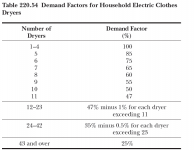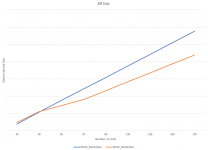Question: 40 apartment (208v 1phase) feed from a meter bank (208v 3phase). each apartment has electrical dyers with 5000KW. Use standard method to calculate the total load for this 40 electrical dryer in meter bank.
220.54 Electric Clothes Dryers — Dwelling Unit(s). The
load for household electric clothes dryers in a dwelling
unit(s) shall be either 5000 watts (volt-amperes) or the
nameplate rating, whichever is larger, for each dryer
served. The use of the demand factors in Table 220.54 shall
be permitted. Where two or more single-phase dryers are
supplied by a 3-phase, 4-wire feeder or service, the total
load shall be calculated on the basis of twice the maximum
number connected between any two phases. Kilovoltamperes
(kVA) shall be considered equivalent to kilowatts
(kW) for loads calculated in this section. (2008 NEC)
When I try to comply with code above (red text). I get confuse. see below. which one is correct?
1.
5000*40*(0.35-(40-23)*0.005)=53000
2.
40/3=13.3
(13+1)*2=28
5000* 28*(0.35-(28-23)*0.005) /2*3=68250
3.
40/3=13.3
(13+1)*2=28
5000* 40*(0.35-(28-23)*0.005)/2*3=97500
220.54 Electric Clothes Dryers — Dwelling Unit(s). The
load for household electric clothes dryers in a dwelling
unit(s) shall be either 5000 watts (volt-amperes) or the
nameplate rating, whichever is larger, for each dryer
served. The use of the demand factors in Table 220.54 shall
be permitted. Where two or more single-phase dryers are
supplied by a 3-phase, 4-wire feeder or service, the total
load shall be calculated on the basis of twice the maximum
number connected between any two phases. Kilovoltamperes
(kVA) shall be considered equivalent to kilowatts
(kW) for loads calculated in this section. (2008 NEC)
When I try to comply with code above (red text). I get confuse. see below. which one is correct?
1.
5000*40*(0.35-(40-23)*0.005)=53000
2.
40/3=13.3
(13+1)*2=28
5000* 28*(0.35-(28-23)*0.005) /2*3=68250
3.
40/3=13.3
(13+1)*2=28
5000* 40*(0.35-(28-23)*0.005)/2*3=97500



